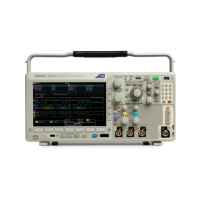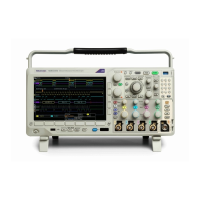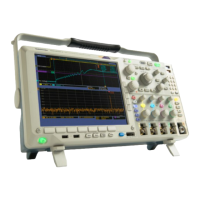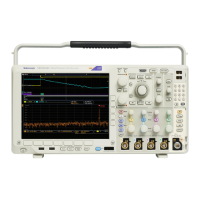Frequent Anomaly
Board label: FREQ_ANOMALY
Grid location: A9
Description: There are two frequently
occurring anomalies in this pulse train.
A half height runt signal occurs approximately
every 104.8 ms. Use a Runt trigger to isolate
the signal.
A 25 ns (narrow) pulse appears
approximately every 104.8 ms. Use a Pulse
Width trigger to isolate the signal.
The pulse train is a repeating group of three
pulses. The three pulses are 100 ns, 200 ns,
and 100 ns wide, with a 100 ns low between.
The group repeats at a 1.6 μs rate.
The anomaly is a group of four pulses. The
four pulses are 100 ns, 50 ns (narrow), 100
ns (runt), and 100 ns wide, with a 100 ns low
between, except for a 50 ns low before the
runt.
I
2
C Bus
Board label: I2C_CLK, I2C_DATA
Grid location: H2, H3
Description: These are the I2C (Inter-IC
Communication) bus signals between the μC
and a serial EEPROM.
There are several different types of data
packets.
The clock rate is a 200 kHz, 0 to 5 volt
signal.
Mode Button
Board label: Mode
Grid location: A11
Description: Press this button to choose
which of the seven alternative signals to send
out of the RF output connector. Your current
choice is identified by which of the seven
related red LEDs is lighted.
Multiple Peaks Demo
The RF output connector generates an array
of frequencies, which are centered around
2.4 GHz, to show the ability of the MDO3000
Series oscilloscopes to dynamically mark
each peak in the frequency domain with its
exact frequency and amplitude.
The red LED labeled “Multiple Peaks” at grid
location B11 turns on.
Spectrogram Demo
The RF output connector generates an
array of frequencies, which are centered
around 2.4 GHz and are both amplitude and
frequency modulated, to show the value of
the Spectrogram function on slowly changing
RF phenomena.
The red LED labeled “Spectrogram” at grid
location B11 turns on.
www.tektronix.com/mdo300048
MDO3000 Series Oscilloscope
Demonstration Guide

